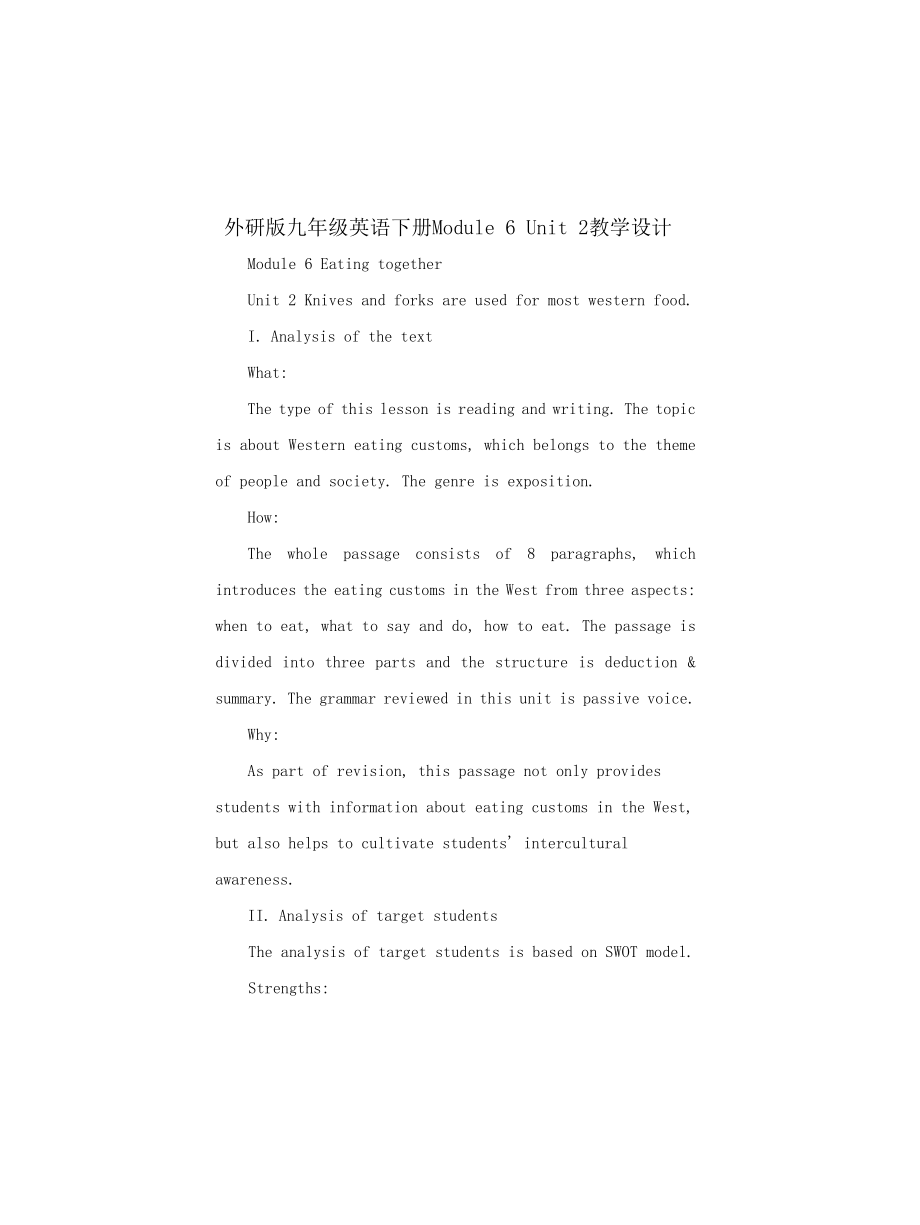《外研版九年級(jí)英語下冊(cè)Module 6 Unit 2 教學(xué)設(shè)計(jì)》由會(huì)員分享�����,可在線閱讀����,更多相關(guān)《外研版九年級(jí)英語下冊(cè)Module 6 Unit 2 教學(xué)設(shè)計(jì)(8頁珍藏版)》請(qǐng)?jiān)谘b配圖網(wǎng)上搜索。
1�、外研版九年級(jí)英語下冊(cè)Module 6 Unit 2教學(xué)設(shè)計(jì)
Module 6 Eating together
Unit 2 Knives and forks are used for most western food.
I. Analysis of the text
What:
The type of this lesson is reading and writing. The topic is about Western eating customs, which belongs to the theme of people and society. The genre is
2、exposition.
How:
The whole passage consists of 8 paragraphs, which introduces the eating customs in the West from three aspects: when to eat, what to say and do, how to eat. The passage is divided into three parts and the structure is deduction & summary. The grammar reviewed in this unit is passi
3��、ve voice.
Why:
As part of revision, this passage not only provides students with information about eating customs in the West, but also helps to cultivate students' intercultural awareness.
II. Analysis of target students
The analysis of target students is based on SWOT model.
Strengths:
Stude
4��、nts are familiar with and have interests in the topic. They also have some abilities in reading and writing.
Weakness:
Students know little about table manners in Western countries.
Opportunities:
Students have the willingness to learn more about Western customs.
Threats:
Students lack logical
5���、 and critical thinking.
III. Teaching objectives
By the end of the class, students will be able to:
Cognize and understand the key vocabulary and grammar.
Predict the topic and content based on the title and pictures.
Find out the details about how to eat Western meals.
Practise through skimmi
6�、ng and scanning to solve reading problems: the main idea and the structure.
Compare the differences between Chinese and Western table manners.
Learn to respect different cultures.
IV. Key points and difficult points
Key points:
Cognize and understand the key vocabulary and grammar.
Predict the
7、 topic and content based on the title and pictures.
Find out the details about how to eat Western meals.
Practise through skimming and scanning to solve reading problems: the main idea and the structure.
Difficult points:
Compare the differences between Chinese and Western table manners.
Learn
8����、to respect different cultures.
V. Teaching methods
PWP
VI. Teaching aids
Multi-media
VII. Teaching steps
Step 1. Pre-reading
1. Lead-in
Lead in the topic with a video about table manners in Western countries, ask students what the video is talking about, and make the students have a free tal
9、k about other Western table manners that they knew.
Purpose:
To attract students' interests and lead students to the theme situation, activate students' existing schema and help students remove word barriers.
2. Predict
Ask students to look at the title and the picture
beside the text and predi
10����、ct the main idea of the passage.
Purpose:
To develop students' predictive skill.
Step 2. While-reading
1. Read for the main idea
① Ask students to read for the main idea and find the golden rule: Do as the Romans do.
② Ask students to read and guess:
Who is the passage written for?
Where mig
11、ht you see a passage like this?
③ Ask students to divide the passage into three parts to get the structure.
④ Ask students to read for genre.
Purpose:
To help students get a general understanding of the passage through skimming and scanning.
2. Read for details
①Ask students to match the topic
12���、s with the paragraphs.
Students should pay attention to the first and last sentences of each paragraph.
②Ask students to read Paragraph 2 and find out the
mealtimes in Western countries.
Read for details.
What are the meal times in some We stern countries?
Lunch:
Dinner>
3 pm
7prn
In S
13��、pain
tOpm
What are the meal times m China?
Lunch: 12pm
Dinner: 6pm
Why are the meal times different ?
③Ask students to read Paragraph 3-7 carefully and complete the blanks.
Read for details.
Para. 3-7 j
At the start of th# meal
During the meal
At the end of the meal
Left: for
14��、k
France
Buon ?叩-titp
When %ErvEd
Thank you
Rrght: knife
Italian
Bon ejppeli t
When gXl ng something Y*u donrt like
iJm
1 don't
ent mer
Things to say Enjoy every dEsih.
Soup: spoon
English
一
Wtien offeretil rjwp food ThJbrl gu c���;』n 5
HoJh.哧% RTit bi/t I've hd-d eri^iwh.
Thing-s t
15�、e do StflV
Telk
Some Food: fingcr-h
Purpose:
To help students understand the passage thoroughly, and confirm students new knowledge.
3. Read for language
Ask students to pay attention to the passive voice and
ask them why the author used “be done” so much.
Purpose:
Help students appreciat
16、e the function of language and get a better understanding of the form and meaning of passive voice.
4. Read for thinking
Ask students to discuss the question:
Why should we do as the Romans do when we are eating a Western meal?
Purpose:
To develop students' critical thinking, enhance their inte
17��、rcultural awareness, let them understand and respect others' culture.
Step 3. Post-reading
1. Compare and contrast
Ask students to use the blank to compare and contrast the different table manners between Western countries and China.
Compare and contrast.
in China
in the west
when to eat
l
18����、unch : 1pm . ^pm
dinner; 7pm i■叩m
lunch : 12pm . 3Pm
dinner: fipm球網(wǎng)呵;眄⑴
what to say
what to da
et th* tUrt of
the m?al
during 曲菱 m&al
■at tht end of
Hi屯 mtal
I French : Quan jippetilns Um h'an a ppebL
EngllihmelhlHf
19、■口 rrv.l durft -eat me-BL
Whe-n
20、hopsticks
5口up: Sipoon
Purpose:
Promote students' analyzing thinking and lay a foundation for imitative writing afterwards.
2. Writing
Ask students to write a passage about how to eat a
Chinese meal. Provide students with writing tips.
Purpose:
Enable students to integrate the writing knowledge about eating customs.
Homework
Polish your passage Chinese eating customs.
 外研版九年級(jí)英語下冊(cè)Module 6 Unit 2 教學(xué)設(shè)計(jì)
外研版九年級(jí)英語下冊(cè)Module 6 Unit 2 教學(xué)設(shè)計(jì)

